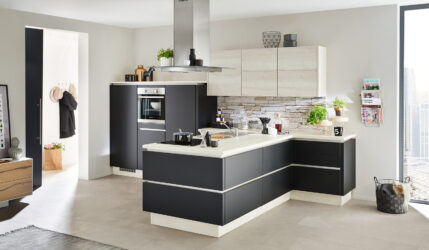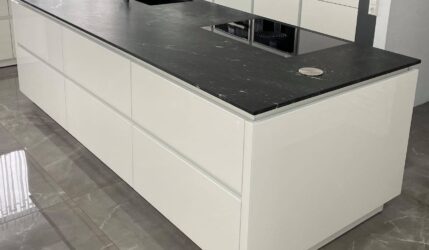What is a Mitered Countertop Edge? Types and More
What Do You Get When You Have Sheet Material Finished in Miter?
Miter is a beveled edge that allows you to make invisible connections and the corners are nicely finished. In the webshop, you can select miter edges on various sheet materials. Select the edge finish on the category page to find out which sheet materials we can finish with miter. Choose an angle of 45 degrees if you want to make a seamless corner. For comparison: if you do not choose a miter, you always see an end face of the sheet material. If you glue two parts with the miter edge together, you get a much tighter corner.
What Exactly is a Miter Joint?
In essence, a miter joint is a corner joint where two pieces of material are cut at a 45-degree angle. 📐 This carefully crafted joint creates a seamless transition, making unsightly seams or gaps a thing of the past. The result? A sleek, professional look that elevates the aesthetic value of your interior.
Why Should You Choose a Miter Joint?
Let’s be honest, there are countless ways to embellish your home. But why should you specifically choose a miter joint? Well, here are a few compelling reasons:
- A Touch of Elegance: A miter joint gives your interior a refined look that is difficult to match with other finishing techniques. It’s like the difference between a tailored suit and a ready-to-wear suit – it simply fits better.
- Increased Durability: A well-executed miter joint is not only beautiful but also strong. It is wear resistant and will last for years, making it a smart investment for the long term.
- Added Value to Your Home: If you ever decide to sell your home, a miter joint will certainly catch the eye of potential buyers. It’s a detail that shows you have an eye for quality and craftsmanship.
Where Can You Apply Miter Joints? 🛠️
The beauty of miter joints is that they are incredibly versatile. You can use them for:
- Baseboards and door frames: Give your baseboards and door frames a sleek, modern look with miter joints. They will look like they came straight from a design magazine.
- Doors and furniture: Whether it’s a cabinet door, a dresser, or a kitchen, a miter joint adds a touch of class to any piece of furniture. It’s the kind of detail that makes the difference between ordinary and extraordinary.
- Walls and ceilings: With miter joints, you can attach decorative moldings or paneling to your walls, giving your interior a unique dimension.
Miter Joints in the USA: A Trend That Continues to Grow 📈
In 2024, miter joints will be an integral part of the Dutch interior design landscape. Whether you have a minimalist, classic, or contemporary interior, a miter joint is always a good choice.
- Minimalist interiors: Here, miter joints are often used to create clean lines and a sense of spaciousness. Think of floating shelves without visible mounting hardware, or a seamless transition between wall and ceiling.
- Classic interiors: In a classic interior, miter joints add a subtle accent to moldings, paneling, and crown moldings, emphasizing the elegance of these elements.
- Contemporary interiors: In a contemporary interior, miter joints can be combined with various materials and textures, such as marble, brass, or velvet, to create a unique and luxurious look.
But it’s not just individuals who like miter joints. Architects and interior designers are also increasingly using this technique in both homes and commercial spaces. From hotels and restaurants to offices, miter joints can be found everywhere. 🏢
This growing popularity has led to a flourishing market for miter joint products and services. There are now more companies than ever specializing in the creation and installation of miter joints, making it accessible for everyone to bring this refined finish into their homes.
Helpful Tips for Working with Miter Joints
- Invest in quality tools: A good miter saw and a miter guide is essential for making precise cuts.
- Practice makes perfect: Start by practicing on scrap wood before tackling your real project.
- Take your time: Haste makes waste. Take the time to carefully execute each cut.
- Use the right glue: Choose a strong wood glue specifically designed for miter joints.
- Sanding and finishing: A smooth, well-finished miter joint is the result of patience and attention to detail.
Frequently Asked Questions About Miter Joints?
What is the difference between a miter joint and a butt joint?
A miter joint is a corner joint where the two pieces of material are cut at a 45-degree angle, while in a butt joint, the two pieces are joined at a 90-degree angle. A miter joint creates a seamless transition, whereas a butt joint often has a visible seam.
Can I make a miter joint myself?
Absolutely! With the right tools, a little practice, and the right instructions, you can create beautiful miter joints yourself. There are countless online tutorials and videos to help you.
Which types of wood are suitable for miter joints?
In principle, you can use any type of wood for miter joints. Hardwood is generally stronger and more durable than softwood, but it is also harder to work with.
How do I maintain a miter joint?
A miter joint is relatively low maintenance. Regular dusting with a soft cloth is usually sufficient. If the joint becomes damaged, you can usually repair it with some wood filler and sandpaper.




